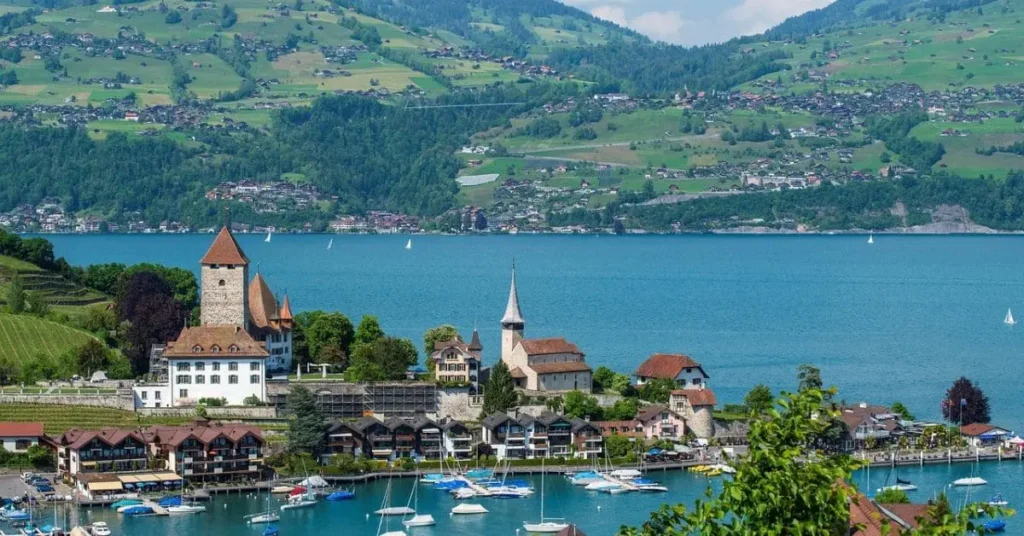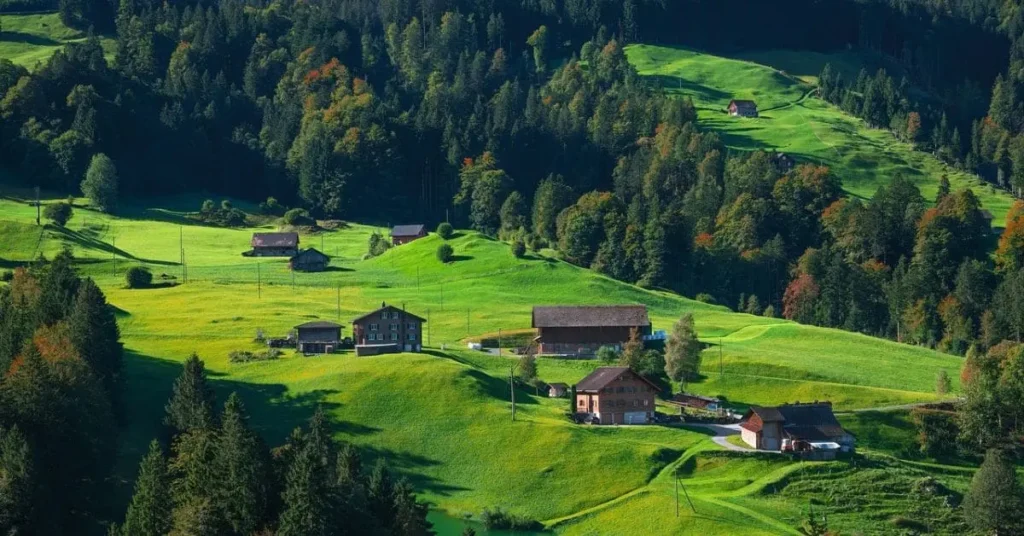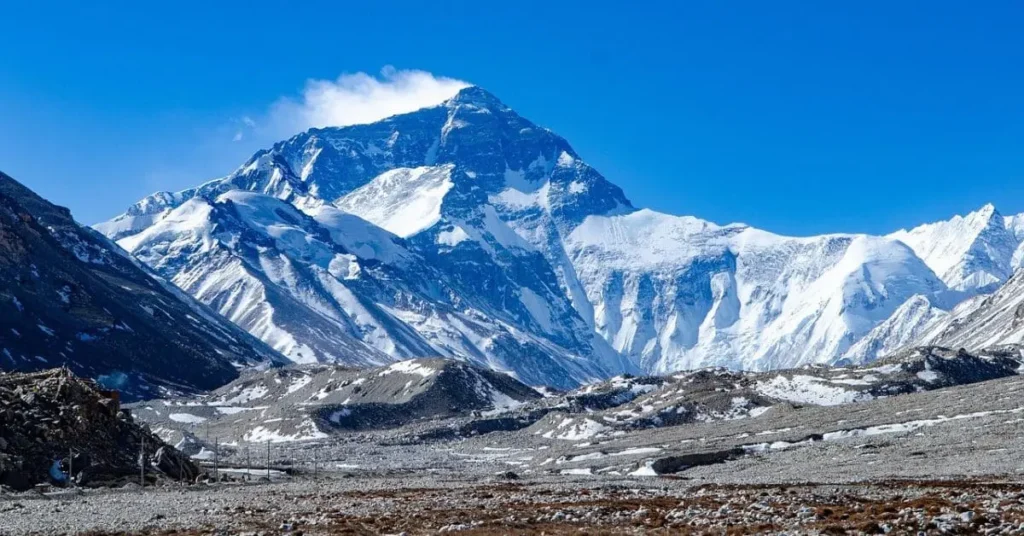Switzerland is a dream destination for travelers seeking breathtaking landscapes, world-class skiing, and charming cities. But when is the best time to travel to Switzerland for the perfect experience? The answer depends on what you want to do—whether it’s hitting the slopes in Zermatt, exploring the scenic trails of Interlaken, or enjoying the cultural charm of Zurich and Geneva.
In this ultimate guide, we’ll break down Switzerland’s seasons, highlight the best months for specific activities, and reveal the peak and off-peak travel times so you can plan a trip that suits your preferences and budget. Whether you’re looking for adventure, relaxation, or savings, this guide will help you make the most of your Swiss getaway.
Table of Contents

Understanding Switzerland’s Seasons – When Is the Best Time to Visit?
Switzerland is a country of diverse landscapes, from the snow-capped Alps to picturesque lakes and vibrant cities. Choosing the best time to travel to Switzerland depends on the experience you’re looking for. Each season offers something unique, whether it’s skiing in Zermatt, hiking in Interlaken, or exploring the cultural gems of Zurich and Geneva. Here’s a breakdown of what to expect in each season:
Spring (March to May): A Blooming Escape
Spring is the perfect time to visit Switzerland if you want to avoid peak-season crowds while still enjoying pleasant weather. As the snow melts, the Alps reveal lush green meadows dotted with colorful wildflowers, making it an ideal time for sightseeing and light hiking. Cities like Lucerne and Montreux come to life with blooming gardens, and this season is great for budget-conscious travelers, as hotel rates and airfare tend to be lower than in summer and winter.
- Average Temperature: 8°C to 15°C (46°F to 59°F)
- Best Activities: Scenic train rides, city sightseeing, light hiking, and lake cruises
- Key Events: Tulip Festival in Morges, Sechseläuten Festival in Zurich
Summer (June to August): Outdoor Adventures & Festivals
Summer is Switzerland’s peak travel season, attracting visitors who want to experience the country’s stunning natural beauty. This is the best time for hiking in the Swiss Alps, exploring Lake Geneva, or taking the famous Glacier Express train ride. Days are long and sunny, perfect for outdoor activities, but expect higher prices and crowded tourist hotspots.
- Average Temperature: 18°C to 28°C (64°F to 82°F)
- Best Activities: Hiking, lake cruises, sightseeing, and paragliding in Interlaken
- Key Events: Montreux Jazz Festival, Swiss National Day (August 1)
Autumn (September to November): Fewer Crowds, Stunning Scenery
If you’re looking for mild weather, fewer tourists, and lower prices, autumn is one of the best times to visit Switzerland. The fall foliage in regions like Lake Geneva, Bernese Oberland, and Lauterbrunnen creates picture-perfect scenery. It’s also a great season for food lovers, as cheese festivals and harvest celebrations take place during this time.
- Average Temperature: 10°C to 20°C (50°F to 68°F)
- Best Activities: Sightseeing, hiking, scenic train rides, and cultural festivals
- Key Events: Alpabzug (cow descent festival), Grape Harvest Festival in Lugano
Winter (December to February): A Wonderland for Snow Lovers
Winter transforms Switzerland into a snow-covered paradise, making it the top choice for travelers who love skiing, snowboarding, and winter markets. The ski resorts of Zermatt, St. Moritz, and Jungfraujoch are at their best during this time. Cities like Zurich and Geneva sparkle with festive lights, and frozen lakes offer unique ice-skating experiences.
- Average Temperature: -2°C to 7°C (28°F to 45°F)
- Best Activities: Skiing, snowboarding, winter hiking, and holiday markets
- Key Events: Winter markets, White Turf horse racing in St. Moritz
Which Season Is Right for You?
- For winter sports enthusiasts: December to February is perfect for skiing and snowboarding.
- For hikers and nature lovers: June to September offers the best weather for exploring the Alps.
- For budget travelers: March to May and September to November provide lower prices and fewer crowds.
- For cultural experiences: Spring and autumn have festivals, local events, and scenic beauty.
By understanding Switzerland’s seasons, you can plan a trip that aligns with your preferences, whether it’s chasing snow-capped peaks, enjoying warm summer hikes, or experiencing the charm of Swiss cities.
The Best Time to Travel to Switzerland for Specific Activities

Switzerland is a dream destination year-round, but the best time to travel to Switzerland depends on the activities you want to experience. Whether you’re planning a ski trip, a scenic hiking adventure, or a relaxing lake getaway, timing plays a crucial role in making the most of your visit. Below, we break down the ideal seasons for different activities so you can plan your trip accordingly.
Skiing & Winter Sports (December to February)
For winter sports enthusiasts, the best time to travel to Switzerland is during the colder months when the Alps are covered in fresh snow. From December to February, Switzerland’s top ski resorts, including Zermatt, St. Moritz, and Davos, offer world-class skiing and snowboarding experiences.
Best Ski Destinations:
- Zermatt – Home to the famous Matterhorn, offering high-altitude skiing with breathtaking views.
- St. Moritz – A luxury winter resort known for its perfectly groomed slopes and high-end accommodations.
- Jungfrau Region (Grindelwald, Wengen, Mürren) – Ideal for family-friendly skiing and stunning mountain panoramas.
- Verbier – A hotspot for advanced skiers looking for challenging slopes and off-piste adventures.
Other Winter Activities: If skiing isn’t your thing, you can still enjoy snowshoeing, winter hiking, ice skating, or visiting Switzerland’s famous winter markets in Zurich, Lucerne, and Geneva.
Tip: Since this is the peak winter season, it’s best to book ski passes and accommodations in advance to secure the best prices.
Hiking & Sightseeing (May to October)
For those who love outdoor exploration, the best time to travel to Switzerland for hiking and sightseeing is from late spring to early autumn. The trails are clear, the lakes are vibrant, and the weather is perfect for long scenic walks through the Alps.
Best Hiking Trails in Switzerland:
- The Matterhorn Trail (Zermatt) – A breathtaking hike with views of Switzerland’s most iconic peak.
- The Eiger Trail (Grindelwald) – A moderate hike that brings you up close to the mighty Eiger North Face.
- Oeschinensee Panorama Trail (Kandersteg) – Offers stunning lake views and easy access for all levels of hikers.
- Five Lakes Walk (Zermatt) – One of the best hikes for photographers, showcasing Switzerland’s crystal-clear alpine lakes.
Other Sightseeing Highlights:
- Take a scenic train ride on the Glacier Express, Bernina Express, or GoldenPass Line.
- Enjoy a Lake Geneva or Lake Lucerne cruise with breathtaking mountain views.
- Visit Interlaken for adventure activities like paragliding and canyoning.
Tip: September and early October are great months for hiking, as the weather remains pleasant, and the summer crowds start to fade.
Luxury & Wellness Retreats (Year-Round)
If you’re looking for relaxation and a luxurious experience, Switzerland offers some of the best wellness retreats and spa resorts. The best time to travel to Switzerland for a luxury getaway depends on whether you prefer snowy mountain views or warm summer landscapes.
Top Wellness Destinations:
- Badrutt’s Palace Hotel (St. Moritz) – A five-star spa retreat with stunning winter views.
- The Chedi Andermatt – Perfect for luxury travelers seeking year-round relaxation.
- Grand Resort Bad Ragaz – One of Switzerland’s most famous thermal spa resorts.
Tip: Many Swiss resorts offer special wellness packages during the off-season, making spring and autumn ideal for spa lovers looking for a more private experience.
Cultural Festivals & City Exploration (Year-Round, but Best in Spring & Autumn)
If your trip is focused on Switzerland’s cities and cultural experiences, the best time to visit is during spring (March-May) and autumn (September-November). These seasons offer comfortable temperatures, fewer crowds, and plenty of festivals.
Best Cities to Explore:
- Zurich – A vibrant cultural hub with museums, shopping, and stunning lakeside views.
- Geneva – Home to the United Nations, luxury shopping, and the famous Jet d’Eau.
- Bern – A UNESCO-listed Old Town with beautiful medieval architecture.
- Lucerne – A charming lakeside city with historical bridges and panoramic mountain views.
Top Festivals to Attend:
- Montreux Jazz Festival (July) – A renowned cultural festival held on the shores of Lake Geneva, celebrated for its vibrant performances and scenic setting.
- Fête de l’Escalade (December, Geneva) – A traditional celebration of Geneva’s rich history.
- Zurich Film Festival (September-October) – A great event for film lovers and culture enthusiasts.
Tip: Visiting in spring or autumn means better hotel deals and a more relaxed sightseeing experience compared to peak summer months.
When Is the Best Time to Travel to Switzerland?
The best time to travel to Switzerland depends entirely on what kind of experience you’re looking for:
- For skiing & winter sports: December – February
- For hiking & sightseeing: May – October
- For cultural experiences & city travel: March – May & September – November
- For wellness retreats & luxury getaways: Year-round
By choosing the right season, you can enjoy Switzerland’s breathtaking landscapes, thrilling activities, and cultural highlights while making the most of your trip.
Switzerland’s Peak and Off-Peak Seasons – When to Find the Best Deals
Switzerland is an incredible travel destination, but the cost of visiting can fluctuate depending on the season. Knowing the best time to travel to Switzerland is key to finding the best deals on flights, accommodation, and activities. By understanding the differences between peak and off-peak seasons, you can plan a more affordable and enjoyable trip. Whether you’re hoping to explore the Swiss Alps, experience the cities, or enjoy outdoor adventures, the timing of your visit can have a significant impact on your overall experience and budget.
Peak Season (December to February & June to August) – High Prices and Busy Attractions
Switzerland experiences two main peak seasons: winter and summer. During these times, Switzerland sees an influx of tourists, leading to higher prices and crowded attractions.
Winter Peak Season (December to February)
The best time to travel to Switzerland for winter sports enthusiasts is during the winter months. Ski resorts like Zermatt, St. Moritz, and Verbier are bustling with skiers and snowboarders. In addition to the mountain resorts, major cities such as Zurich, Geneva, and Lucerne are also popular during this time, offering snow-covered landscapes and festive winter activities.
Why Visit During the Winter Peak Season?
- Ideal conditions for skiing and snowboarding
- Winter festivals and holiday markets add a festive touch to cities.
- Magical snowy scenery across the Swiss Alps
How to Save Money in Winter?
- Book your accommodation and ski passes well in advance to secure the best rates
- Opt for smaller, lesser-known ski resorts that offer more affordable options
- Consider visiting early December to avoid the higher prices closer to the holidays
Summer Peak Season (June to August)
Summer is another peak season for travelers, with perfect weather for outdoor activities such as hiking, sightseeing, and lake cruises. Cities like Zurich, Geneva, and Interlaken are bustling with tourists, which drives up the prices for accommodation and attractions.
Why Visit During the Summer Peak Season?
- Ideal weather for outdoor adventures and exploration
- Alpine meadows and picturesque lakes are at their best
- Major festivals and events, such as the Montreux Jazz Festival, draw large crowds
How to Save Money in Summer?
- Visit during late May or early September when the crowds are smaller, and the prices are more affordable
- Book flights and hotels early to take advantage of the best rates
- Use a Swiss Travel Pass to get discounts on trains, buses, and boats
Off-Peak Season (March to May & September to November) – Lower Prices and Fewer Crowds
The best time to travel to Switzerland for those looking for budget-friendly options is during the off-peak season. These months typically offer lower prices for flights, accommodation, and activities, with fewer crowds compared to peak season.
Spring Off-Peak Season (March to May)
Spring in Switzerland is a delightful time to visit. The weather is generally mild, and the landscape begins to bloom with wildflowers and lush greenery. The ski season begins to wind down by March, and by April and May, many of the major ski resorts start to close. However, this period offers great deals and a quieter atmosphere, especially for city sightseeing and cultural activities.
Why Visit During Spring?
- Lower accommodation rates compared to peak seasons
- Fewer crowds at popular attractions and in cities
- Beautiful spring landscapes with blooming flowers
How to Save Money in Spring?
- Book hotels and flights several months in advance to lock in cheaper rates
- Visit during early May for milder temperatures and fewer tourists
- Take advantage of discounted prices at museums and galleries
Autumn Off-Peak Season (September to November)
Autumn is an excellent time to visit Switzerland for those looking to avoid the summer crowds and still enjoy pleasant weather. The best time to travel to Switzerland for outdoor activities such as hiking is typically in September and October, when the weather is still warm, but the crowds start to thin out. The stunning autumn foliage adds a magical touch to the Swiss landscape.
Why Visit During Autumn?
- Reduced prices on accommodation and activities
- Stunning fall foliage across the Swiss Alps and cities
- Perfect weather for hiking and exploring towns
How to Save Money in Autumn?
- Travel during late September or early October to enjoy cooler weather without the crowds
- Stay in local guesthouses or budget-friendly hotels
- Use a Swiss Half Fare Card for discounted travel on public transportation
Shoulder Season – A Perfect Balance of Price and Experience
If you’re looking for a time when you can enjoy lower prices without sacrificing great experiences, the shoulder season is the perfect option. This period occurs between peak and off-peak seasons and includes late May to early June and mid-September to early October. These months offer milder weather, fewer crowds, and more affordable prices, making it the best time to travel to Switzerland for a balanced experience.
Why Visit During the Shoulder Season?
- Lower costs for flights and accommodation
- Great weather for both city exploration and outdoor adventures
- Less crowded attractions, allowing for a more relaxed experience
How to Find the Best Deals in the Shoulder Season?
- Book flights and hotels early to secure discounted rates
- Take advantage of seasonal promotions for train and activity passes
- Plan your visit to major cities and attractions during the weekdays for the best experience
The Best Time to Travel to Switzerland for the Best Deals
The best time to travel to Switzerland for great deals depends on your priorities. If you’re looking for skiing, winter sports, or festive activities, the winter season may be the ideal choice, but be prepared for higher prices. If outdoor adventures, hiking, and sightseeing are your main focus, then the spring and autumn months offer lower prices and fewer crowds, making them the best time to travel to Switzerland for budget-conscious travelers. The shoulder season offers a wonderful balance of affordability, great weather, and fewer tourists, ensuring you can enjoy all that Switzerland has to offer without the high season prices.
By planning your visit according to these peak and off-peak seasons, you can make the most of your Swiss getaway while staying within your travel budget.
Monthly Breakdown – Switzerland Weather & Travel Tips
Switzerland is a year-round destination, but the best time to travel to Switzerland depends on your preferences for weather, activities, and budget. Each month brings something unique, from snow-covered mountains in winter to blooming landscapes in spring, vibrant summer festivals, and golden autumn scenery. This monthly guide will help you decide when to visit based on weather conditions, crowd levels, and the best activities.
January – A Winter Wonderland for Ski Lovers
Weather: Cold and snowy, with temperatures ranging from -2°C to 5°C (28°F to 41°F) in most regions. Alpine areas are much colder.
Why Visit?
- Best time to travel to Switzerland for skiing, snowboarding, and winter sports in resorts like Zermatt, St. Moritz, and Verbier.
- Magical winter scenery with frozen lakes and snow-covered landscapes.
- New Year celebrations in cities like Zurich and Geneva.
Travel Tips:
- Book accommodations early, as ski resorts fill up quickly.
- Wear warm, layered clothing for outdoor activities.
- Take the Glacier Express for stunning winter views.
February – Peak of Ski Season & Romantic Escapes
Weather: Similar to January, with heavy snowfall in mountain regions and temperatures between -1°C and 7°C (30°F to 45°F).
Why Visit?
- Still perfect for winter sports with excellent snow conditions.
- Less crowded than January after the New Year rush.
- Romantic getaways for couples, including scenic lake towns like Lucerne and Montreux.
Travel Tips:
- Consider less touristy ski resorts like Andermatt for lower prices.
- Visit thermal spas in Leukerbad to relax after skiing.
- Pack waterproof gear to stay dry in the snow.
March – Transition from Winter to Spring
Weather: Gradually warming, with temperatures between 2°C and 12°C (36°F to 54°F). Snow remains in the Alps, but lower regions start thawing.
Why Visit?
- Best time to travel to Switzerland for late-season skiing with fewer crowds.
- Lower prices in ski resorts as the season winds down.
- Early spring blossoms in cities like Geneva and Lugano.
Travel Tips:
- Ski passes may be discounted toward the end of the season.
- Explore indoor attractions like museums and historic sites in cities.
- Check road conditions if driving in mountainous areas.
April – Spring Awakens Across Switzerland
Weather: Mild with occasional rain, ranging from 5°C to 15°C (41°F to 59°F). Snow melts in lower altitudes.
Why Visit?
- Best time to travel to Switzerland for budget-friendly travel, as hotels and flights are more affordable.
- Flower blooms in the Lavaux vineyards and Zurich’s parks.
- Fewer tourists, making it great for city sightseeing.
Travel Tips:
- Bring a waterproof jacket, as April can be rainy.
- Take advantage of discounted travel passes before the summer rush.
- Visit Lake Geneva for scenic walks and spring festivals.
May – Perfect for Nature and Sightseeing

Weather: Warmer, with temperatures 10°C to 20°C (50°F to 68°F). Snow remains only in high-altitude regions.
Why Visit?
- Hiking trails start reopening, especially in Interlaken and Lauterbrunnen.
- City tourism is ideal, with comfortable weather and fewer crowds.
- Swiss countryside is lush and green, perfect for scenic train rides.
Travel Tips:
- Hiking trails may still be muddy from melting snow, so wear waterproof shoes.
- Visit Rhine Falls, which is at its fullest due to spring meltwater.
- Book hotels in advance, as the tourist season starts picking up.
June – Start of the Summer Hiking Season
Weather: Warm and pleasant, ranging from 14°C to 24°C (57°F to 75°F).
Why Visit?
- Best time to travel to Switzerland for hiking, biking, and lake activities.
- Scenic train rides, such as the Bernina Express, are at their best.
- Alpine flowers are in full bloom, making it a photographer’s paradise.
Travel Tips:
- Book accommodations early, as summer is a popular time for travel.
- Consider a Swiss Travel Pass for unlimited train rides.
- Pack light layers, as the weather can be warm in the valleys but chilly in the mountains.
July – Peak Summer and Outdoor Adventures
Weather: Warmest month, with temperatures between 16°C and 28°C (61°F to 82°F).
Why Visit?
- Best time to travel to Switzerland for adventurers, hikers, and nature lovers.
- Lakes are ideal for swimming, with destinations like Lake Geneva and Lake Lucerne bustling with activity.
- National Day celebrations (August 1st) feature fireworks and festivities.
Travel Tips:
- Popular spots like Jungfraujoch and Matterhorn Glacier Paradise can be crowded.
- Book train tickets in advance for scenic routes like the GoldenPass Line.
- Stay hydrated and wear sunscreen during long hikes.
August – Warm Weather and Summer Festivals
Weather: Similar to July, with long sunny days and occasional rain.
Why Visit?
- Festivals like the Locarno Film Festival and Swiss National Day celebrations.
- Alpine villages are lively, with outdoor markets and local events.
- Hiking and paragliding in Interlaken are at their best.
Travel Tips:
- Reserve accommodations early, as August is peak tourist season.
- Visit less crowded regions like Ticino for a quieter experience.
- Use cable cars early in the day to avoid queues.
September – Ideal for Budget and Outdoor Travel
Weather: Cooler, with temperatures 12°C to 22°C (54°F to 72°F).
Why Visit?
- Best time to travel to Switzerland for those looking to save money while still enjoying warm weather.
- Autumn colors start appearing, making it great for photography.
Travel Tips:
- Enjoy less crowded hiking trails before winter begins.
- Take a Lake Geneva cruise for scenic views.
October – Stunning Fall Foliage and Lower Prices
Weather: Crisp, with temperatures 8°C to 18°C (46°F to 64°F).
Why Visit?
- Swiss landscapes turn golden and red, creating stunning views.
- Best time for scenic train rides like the Glacier Express.
- Lower prices on flights and accommodations.
Travel Tips:
- Pack warm clothing, as nights get chilly.
- Visit Lake Lugano, where autumn colors are breathtaking.
- Enjoy seasonal foods like Swiss fondue.
November – Quietest and Cheapest Month to Visit
Weather: Cold, with temperatures 2°C to 10°C (36°F to 50°F).
Why Visit?
- Fewest tourists, meaning no crowds at attractions.
- Deep discounts on hotels and flights.
- Early ski resorts start opening in late November.
Travel Tips:
- Pack warm layers, as winter approaches.
- Check for seasonal closures before visiting attractions.
- Take advantage of off-season hotel rates.
December – Festive Charm and Ski Season Begins
Why Visit?
- Best time to travel to Switzerland for winter markets and seasonal magic.
- Ski resorts open fully, making it great for winter sports.
Switzerland offers something special every month, making it an exciting destination all year round.
Essential Tips for Planning Your Trip to Switzerland
Planning your dream trip to Switzerland requires thoughtful preparation to make sure you visit at the best time to travel to Switzerland and experience all this beautiful country has to offer. With its diverse landscapes and a range of activities to enjoy throughout the year, timing your visit correctly can ensure that you get the most out of your Swiss adventure. Here are some essential tips to help you plan your perfect trip, from the best time to travel to Switzerland for winter sports to choosing the right season for hiking and sightseeing.
1. Choose the Best Time to Travel to Switzerland
When planning a trip to Switzerland, the first step is to determine the best time to travel to Switzerland based on your preferences. Different seasons offer different experiences, and the ideal time will depend on what activities you want to enjoy.
- Winter (December to February): If skiing, snowboarding, or winter sports are at the top of your list, the best time to travel to Switzerland is during the winter months when the ski resorts are open, and the Swiss Alps are covered in snow. Destinations like Zermatt and St. Moritz become winter wonderlands, making it a dream destination for snow enthusiasts.
- Spring (March to May): For a quieter experience with pleasant weather, spring is one of the best times to travel to Switzerland. The temperatures are mild, and the tourist crowds are thinner. It’s perfect for those who want to experience hiking, sightseeing, and the beautiful Swiss countryside at its best.
- Summer (June to August): If you’re looking to enjoy long days filled with outdoor activities like hiking, cycling, and lakeside relaxation, summer is the best time to travel to Switzerland. The weather is warm, and the country’s lakes and parks come alive. However, it’s also the peak season, so expect more tourists and higher prices.
- Autumn (September to November): For fewer crowds and comfortable temperatures, autumn is an excellent time to visit. The fall foliage adds a beautiful touch to the landscape, and you can still enjoy many outdoor activities without the summer rush.
Tip: Don’t forget to check local festivals and events that might coincide with your travel dates. Switzerland hosts amazing festivals like the Locarno Film Festival or the Montreux Jazz Festival, which can offer a unique experience during your visit.
2. Plan Your Itinerary Around Switzerland’s Regions
Switzerland is divided into distinct regions, each offering its own charm and attractions. Depending on the best time to travel to Switzerland, you might want to focus on specific areas.
- Swiss Alps: If your main goal is to experience the iconic Swiss Alps, skiing, or hiking, Zermatt, Grindelwald, and St. Moritz are top destinations. The best time to travel to Switzerland for winter sports is from December to March, while late spring and early autumn are ideal for hiking and sightseeing.
- Lake Geneva Region: For those seeking culture, scenic lakeside views, and unique experiences, Lake Geneva provides a beautiful getaway. The ideal time to visit Switzerland in this region is during the warmer months of June to August, offering the perfect weather for boat rides and exploring picturesque towns like Montreux and Lausanne.
- Zurich and Lucerne: Zurich is a great mix of history and modernity, and Lucerne is known for its picturesque setting. These cities are perfect to visit year-round, but the best time to travel to Switzerland for city exploration would be from April to October when the weather is mild and the outdoor attractions are more accessible.
Tip: While the best time to travel to Switzerland may vary depending on your interests, using public transportation like trains and boats is an excellent way to move between these beautiful regions, saving you time and allowing you to see more of the country.
3. Budgeting for Your Trip
Switzerland is known for being one of the more expensive countries in Europe. However, traveling at the best time to travel to Switzerland can help you save money while still enjoying everything the country has to offer.
- Off-Peak Travel: The best time to travel to Switzerland for budget-conscious travelers is during the off-peak seasons, particularly in the months of November and early December, or late spring and early autumn. During these times, you can find better deals on flights, accommodations, and activities, as prices are lower and there are fewer tourists.
- Accommodation: Switzerland offers a range of accommodations from luxury hotels to budget-friendly hostels. Booking in advance during the shoulder seasons can help you secure good rates, especially if you’re traveling in popular destinations like Zurich or Interlaken.
- Food: Eating out in Switzerland can be pricey, so consider buying food at local supermarkets or enjoying affordable meals at smaller restaurants and cafés. If you’re traveling in the best time to travel to Switzerland for summer, picnicking in one of the country’s many parks or lakesides is an enjoyable and budget-friendly option.
Tip: Consider getting a Swiss Travel Pass, which provides unlimited travel on trains, buses, and boats and offers discounts to various museums and attractions across Switzerland. It’s a great way to save money while exploring the country.
4. Master the Swiss Culture and Etiquette
Switzerland has a unique culture that values politeness and punctuality. Familiarizing yourself with the local customs and etiquette will ensure a positive experience during your trip.
- Greetings and Manners: When meeting someone in Switzerland, it’s common to greet with a firm handshake. Swiss people are known for their punctuality, so make sure to arrive on time for any scheduled activities or transportation.
- Language: Switzerland has four official languages: German, French, Italian, and Romansh. Depending on where you travel, it’s a good idea to learn a few basic phrases in the local language. In larger cities, English is widely spoken, but learning simple greetings in German, French, or Italian can be appreciated.
- Tipping: Tipping is not compulsory in Switzerland, as service charges are often included in the bill. However, rounding up the bill or leaving a 5-10% tip is common if the service was particularly good.
Tip: Always be mindful of the quiet zones in public places, such as trains and buses, where Swiss people highly value peace and tranquility.
5. Pack Smart for the Swiss Weather
Switzerland’s weather can vary dramatically depending on the region, the altitude, and the season. Packing appropriately for the best time to travel to Switzerland will ensure you stay comfortable throughout your trip.
- Winter: If you’re visiting Switzerland during the best time to travel to Switzerland for winter sports, pack warm, waterproof clothing, thermal layers, and ski gear. Ski resorts like Zermatt and St. Moritz offer rentals, but bringing your essentials like gloves and hats will keep you warm on the slopes.
- Spring and Autumn: The spring and autumn months offer mild temperatures, but it can be unpredictable, so pack layers and a light jacket. A raincoat or umbrella is also a good idea as these seasons tend to see more rainfall.
- Summer: For summer, pack light clothing for daytime activities, but bring a warmer jacket for the evenings, especially in mountain regions where the temperatures can drop. Don’t forget comfortable hiking shoes if you plan on exploring Switzerland’s beautiful trails.
Tip: Always be prepared for the Swiss mountains’ unpredictable weather. Even in summer, temperatures can be cold at high altitudes, so bring extra layers and check the forecast before heading out for hiking or sightseeing.
By following these essential tips for planning your trip to Switzerland, you’ll be well on your way to having a fantastic vacation that aligns with the best time to travel to Switzerland for your personal preferences. Whether you’re looking for adventure, relaxation, or cultural exploration, choosing the right time to visit will set the stage for an unforgettable experience.
Conclusion
Switzerland is a country that offers something for every traveler, whether you’re seeking thrilling outdoor adventures, serene alpine views, or rich cultural experiences. To ensure you have the best trip possible, timing is key. The best time to travel to Switzerland depends on your personal interests and the activities you want to enjoy.
Winter is perfect for skiing and snowboarding enthusiasts, while the summer months invite outdoor lovers to explore hiking trails and vibrant lakesides. Spring and autumn offer a quieter, more affordable experience, with ideal conditions for sightseeing and enjoying the beauty of the Swiss landscape without the crowds.
By considering the seasons, the activities you wish to do, and the best time to visit specific regions, you can plan your trip around what suits you best. With a little research and preparation, you’ll be able to experience Switzerland at its finest. Whether you visit for the crisp mountain air or the lively city atmosphere, choosing the best time to travel to Switzerland will ensure a trip that exceeds all your expectations.
Start planning today, and get ready for an unforgettable adventure in one of Europe’s most stunning destinations!






